
Fuller hair with an hair transplantation
Celebrities like Elon Mask, Wayne Ronney, Robbie Williams have already done it, as have many other women and men, a hair transplant for hair loss. Medication and hair loss remedies can slow down hair loss or, in the best case, even stop it, but to grow hair again on bald areas, this is only offered by a hair transplant.
However, transplantation is a special procedure and should only be carried out by specialists with sufficient know-how and experience. Please read the following information on how a transplantation works, for whom it is suitable and how the procedure is carried out.
Information on the basic principle: How does A transplantation work?
Hair transplant is the transplantation of “own hair” and, in other words, the surgical redistribution of “hair roots, which are insensitive to male hormones (DHT), to previously bald areas. Transplanted to these previously bald areas, this insensitivity to the harmful male hormones (dihydrotestosterone) remains – and this is the principle of the surgery – and the redistributed hair follicles continue to grow there for life. In principle, it is only a redistribution of one’s own hair (transplanting hair from other people is not possible!).
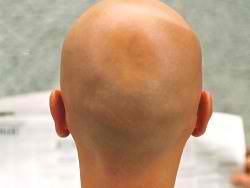
Typically, men who have male pattern baldness will still have a permanent band of hair surrounding the sides and the back of their head.
One often notices that bald people usually always keep a permanent rim of hair surrounding the sides and the back of their head. Due to predisposition (heredity) of the gene information and under the influence of male hormones, certain hair roots can be damaged so that the hair falls out (hereditary hair loss). Usually, “receding hairline” forms first, then the “hairline”, the “top of the head” and the “crown area” at the back of the head are also affected. These changes can also occur in women. Other hair roots (beard and body hair, hair crown) are insensitive to male hormone and therefore never fall out.
This knowledge is used by taking insensitive hair roots from the donor area and inserting them into bald areas. There they continue to grow normally for the rest of the patient’s life (see additional information) and produce healthy hair that can be washed, blow-dried, colored or permed as normal.
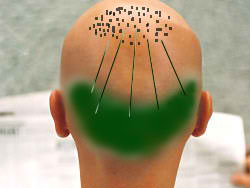
Statistics: Why do hair loss sufferers underwent transplantation? What is the motivation?
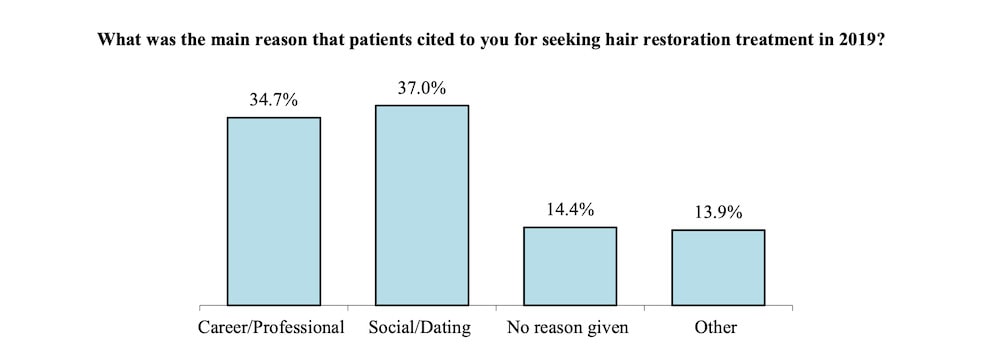
For many men and women, this is one of the biggest concerns. We are talking about hair loss, which is obviously visible to the outside world and which is a no-go par excellence for many. What is the motivation of hair loss sufferers to underwent hair restoration surgery?
According to ISHRS1, 37% of all patients underwent surgery in 2019 to have a better chance of finding a partner and social dating in general. 34.7% of patients underwent a transplantation solely for professional and career reasons.
Definition
“Hair transplantation (hair restoration) is a redistribution of hair. Hair roots are transplanted from hormone-insensitive areas (donor area) to previously bald areas or between existing hair for hair thickening/filling. The aim is to redistribute the hair follicles so skilfully and aesthetically that the result is as maximum as possible and thus brings the maximum possible aesthetic improvement. The hair available for salvage, i.e. the harvesting area, is only available in limited quantities and must last a lifetime. For this reason, the responsible surgeon always plans for the necessary safety reserves so that further progressive hair loss can be corrected by further operations that may be required.
Statistics: Information on the number of hair surgeries performed worldwide

According to ISHRS, approximately 735,312 hair transplants were performed worldwide in 2019 and 106,949 of these were performed in Europe!1
Statistics: What is the average age of patients who UNDERGOING TRANSPLANTATION?
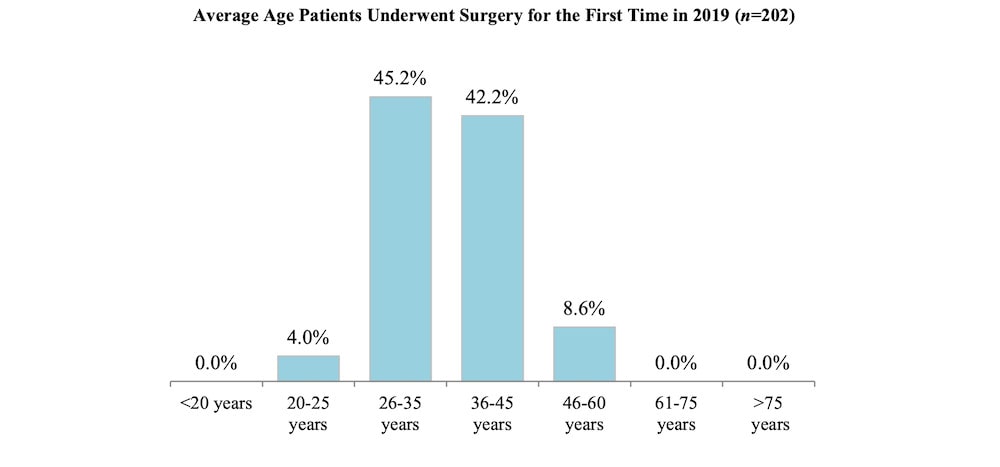
According to ISHRS1, the main patients for hair transplantation among your federation-affiliated physicians are 26-35 year olds at 45.2% and continue to be 36-45-year-olds at 42.2%. At the age of 46-60, only 8.6 % still opt for a transplant.
FACTS about the theory of donor dominance – How long does a transplant last? Important additional information about the permanence of the result and scientific basis
The concept of hair transplant is based on the theory of donor dominance in androgenetic hair loss. When a graft is taken from an area destined to bear hair permanently and transplanted into an area suffering from male pattern baldness, it will, after an initial period of effluvium on grow hair in its new place for the same length of time as would have been the case in its original place. This is the scientific basis of hair transplantation.2
It must be mentioned that the rim of hair can “thin out” with age and at a higher age, especially with a high degree of baldness such as NW 6. In such cases, the result of the hair transplantation also becomes “thinner” with age
By the way, it is suspected that the active ingredient finasteride (read about finasteride to stop hair loss and treat it with medication) could also be beneficial after a hair transplant and can stop or at least weaken this process.
For whom is a Surgery an option?
Hair transplant can be performed on women and men (women please read the women’s chapter).
However, it is PRINCIPALLY important that only hereditary hair loss is present and that the donor area is still in good condition!
In women, hair transplantation is possible if there is alopecia androgenetic hair loss (AGA) of the male type with receding hairline and of the female type with a middle parting light pattern according to Ludwig.3
If pathological hair loss is present, transplantation cannot be performed in the vast majority of cases. In the case of Alopecia Areata (circular hair loss), only if there are only small hairless areas and there has been no hair loss for at least 1 year after therapy4
If there are cases of Norwood 7 in the family (see Norwood scale), hair restoration should also not be considered, as in these cases often (there are exceptions, but rare) only a very limited area of donor hair is available, which does not allow aesthetically satisfactory thickening in the case of pronounced, extensive balding.
Statistics: What is the proportion of Hair Restoration Surgeries performed by women and men?

According to ISHRS, of all hair surgery procedures performed in 2019, 84.2% men and 15.8% women performed a transplantation1 ‘
Information on the limited donor area, further hair loss and careful planning
However, there are only limited hair follicles available for “redistribution” in the donor area. Therefore, it is absolutely important to choose a trustworthy, reputable and experienced surgeon for hair transplantation. This surgeon will plan carefully and also include any interventions that may be necessary at a later date, in case the hair loss should progress in other areas and a further transplantation of the patient’s own hair should be required for follow-up care.
FACTS about the additional option of BHT: Transplantation of body hair with Follicular Unit Extraction in case of poor donor hair
As mentioned above, hair transplantation is normally not possible if there is not enough donor hair available. But thanks to the modern FUE (Follicular Unit Extraction) procedure, it is even possible today to transplant body hair, i.e. to take hair from the body as donor hair, from the back, from the chest, from the arms and legs as well as from the beard
Dr. Sanusi Umar from Los Angeles, USA informs in the article of Researchgate5 about his experience of the surgery on 122 patients and concludes that FUE with the use of body hair can be an effective option for a selected group of patients who have good hair on the body and who suffer from severe hair loss, large bald areas and do not have enough donor grafts in the normal donor area.
Methods and method comparison
Currently, there are two techniques of hair transplantation that have become the latest standard over the last few years. They differ mainly in the method of harvesting. See the table below for more information (the table scrolls left and right depending on your screen resolution)
| Method comparison | FUT strip technique | FUE hair transplantation |
|---|---|---|
| Harvesting the grafts/follicular units | In the FUT technique, the hair follicles are removed from the back of the head in a strip of skin and prepared for distribution under a microscope. By surgically removing a complete strip of skin, 2000 to 4000 grafts (or significantly more, depending on the elasticity of the scalp) can be harvested at once. The resulting wound at the back of the head is then surgically closed | With the FUE technique (single extraction) the hair roots are taken individually from the donor area, isolated into grafts with 1-4/5 hair follicles, and transplanted into the thinned out areas. Since hair roots are taken one by one, this method requires more time |
| Duration of the extraction | Depending on the number of grafts, 30 minutes to 1 hour | Depending on the number of grafts and depending on the clinic and whether they are harvested manually or with a micromotor, only a few hours or spread over several days |
| Maximum number of grafts in one session | Depending on the elasticity of the scalp, the density of the hair and the size of the hairline, and also depending on the experience and size of the team of technicians, 4000-5000 grafts or even considerably more (but considerably less frequently) | Depending on the size and density of the rim of hair, up to 4000 grafts or even more, but usually spread over 2-3 days by renowned hair surgeons |
| Suitable for whom? | People with good scalp elasticity and people who like their hair to be over 1.2 – 1.5 cm long at the level of the scar in the hairline. Also for those who have a great need for donor hair and those who do not like to be shaved in the crown of the hair | For lovers of short haircuts who, for example, like to have their hair 1-3 mm short in the crown |
| Anaesthesia | Local anaesthesia always where the work is being done | Local anaesthesia always where the work is being done |
| Scars | After a strip surgery, a linear scar is created. The extent of the scar, the width and thickness of the scar depends on the number of grafts taken, the closure technique, the know-how and experience of the doctor, and the elasticity of the scalp, as well as the healing behaviour/scar tendency of the patient. If performed professionally and by experienced doctors and with good prerequisites of the patient, scars of only 1-3 mm can remain, which still allows for quite short haircuts. | After an FUE, small, fine, round scars develop which, however, can hardly be seen by the human eye if the hair is expertly removed. The size and visibility of the scars are strongly dependent on the know-how and experience of the doctor, as well as the type and size of the removal instruments used. Are the grafts removed manually or with a micro motor? If the latter, with a micromotor from which manufacturer and with which punch sizes? |
| Risk/risks | Donor area: Wider scar which makes it necessary to wear the hair in the band of hair long. Also the risk of prolonged tightness and numbness Reception area: With both methods poor growth rate unnatural hairline, thick grafts, toilet brush effect, cobblestoning, and pitting | Donor area: Decimated hair crown and “overharvesting”, moth-eaten and football field appearance. As a result, this not only brings visual and aesthetic damage but also ruins the graft reserves in the donor area, with no options for the future. Recipient area: Poor growth rate unnatural hairline, thick grafts, toilet brush effect, cobblestoning and pitting with both methods |
| When is sport possible again after hair restoration? | After the surgery no sport should be done for at least 14 days and fitness training should ideally be avoided for 2-3 months. The risk increases so that the scar expands and a wider scar develops | After an FUE, you can start doing some sports such as light jogging and cycling after only 10 days |
| Temporary Shockloss | Both methods! Applies to compaction (but can also occur in adjacent areas of 1-3 cm next to the grafted area): When hair is transplanted into areas that are still hairy, the stress of the operation, the anesthetic, etc. can cause existing hair follicles to go dormant, which means that for 3-5 months after the transplant you may look slightly worse than before the operation. Temporary shock loss, however, is only “temporary” and after 3-5 months the situation will gradually improve, when the growth of new hair will also slowly start | Both methods! Applies to compaction (but can also occur in adjacent areas of 1-3 cm next to the transplanted area): If the hair is still growing, the stress of the operation, the anesthesia, etc. can cause existing hair follicles to fall into a resting phase, which means that for 3-5 months after the transplant you may look somewhat worse than before the operation. Temporary shock loss, however, is only “temporary” and after 3-5 months the situation will gradually improve as the new hair slowly starts to grow. |
| Permanent Shockloss | Both methods! Applies in case of compaction (but can also occur in adjacent areas of 1-3 cm next to the transplanted area) If the hair is still growing, the stress of the operation, the anesthesia, etc. can cause existing hair to fall into the resting phase, with the result that 1. for 3-5 months after the hair transplantation you look slightly worse than before the operation (as with temporary shock loss), but 2. in the case of permanent shock loss, the hair is so traumatized by the stress of the surgery, the anesthesia etc. that they are damaged forever. The risk is all the higher the thinner the existing hair has already become due to hereditary hair loss. Unfortunately, it is not possible to predict how sensitive hair that has already become thinner is and whether it will survive the operation or not. | Both methods! Applies to thickening (but can also occur in adjacent areas of 1-3 cm next to the transplanted area) If hair is thickened in areas that still have hair, the stress of the operation, the anesthetic, etc. can cause existing hair to fall into a resting phase, which means that 1. for 3-5 months after the hair transplantation, one looks somewhat worse than before the surgery (as with temporary shock loss), but 2. in the case of permanent shock loss, however, the hair is so traumatized by the stress of the surgery, the anesthetic etc. that they are damaged forever. The risk is all the higher the thinner the existing hair has already become due to hereditary hair loss. Unfortunately, it is not possible to predict how sensitive hair that has already become thinner is and whether it will survive the operation or not. |
| Is shaving required for the transplant? | No at the back of the head and no in the area to be transplanted. However, depending on the hair situation, a hair surgeon may recommend shaving in the reception area | The back of the head: Usually yes and the area to be transplanted is usually yes too. However, there are now some hair surgeons who at least do without a shave in the recipient area and only shave in the hairline. In the hairline, either a strip shave or a GJ cut can be performed (depending on the number of grafts). In the meantime, there is also an FUE without any shaving, the Unshaven FUE variant without shaving in the receiving area plus no shaving in the harvesting area. However, this method is expensive and is only performed by very few hair surgeons |
| Social fitness after hair transplantation | Depending on the shave, a 14-day leave of absence is generally recommended | Depending on the shave, a 14-day holiday is generally recommended. If there is still enough remaining hair and if this is not shortened and thus the cover for the resulting traces after the hair transplantation (redness/crusting) is possible, then possibly a social fitness of less than one week or is it even possible to go back to work one day after the operation without anyone being able to recognize a surgical intervention (for example, possibly possible when transplanting a smaller number of grafts into the receding hairline) |
Statistics: How many patients choose the FUE technique and how many patients choose the FUT strip technique?

According to ISHRS, of all hair transplants performed in 2019, a total of 66% of patients opted for transplantation using the FUE technique and 29.8% of patients opted for a FUT strip technique1
How much does hair restoration surgery cost?

For all those interested, it is important to know what one has to spend financially for such a special surgical procedure as a hair transplant. What a hair transplantation costs is always strongly dependent on the respective situation. Which status according to the NW table has one already achieved and which status would one like to achieve with the hair transplantation? How much area has to be planted therefore strongly determines how many grafts are needed for the hair restoration.
For large bald areas such as NW 6, 7000-8000 grafts can be needed quickly and the cost of hair transplantation can range from 14,000 – 40,000 Euros depending on the doctor. For small areas such as only receding hairline like NW 2, only 1000 – 1500 grafts may be needed and the eventual cost of hair transplantation is only 2000 – 5000 or 3000 – 7,500 Euros.
Read more details about hair transplant prices here.
Hair transplantation and other frequently asked questions and answers
The procedure is possible for both men and women. Provided there is hereditary hair loss (androgenetic hair loss/AGA) and there is still enough hair available in the harvesting area (hairline/donor area) that can be harvested and transplanted as donor hair. Consequently, patients with other diagnoses of hair loss and patients with too few donor hairs (insufficient hair crown) cannot be treated with hair transplantation. These include, for example, sufferers of alopecia areata and also sufferers of diffuse hair loss.u003cbru003eu003cbru003eHair transplantation has been proven to be the most effective method for the treatment of androgenetic hair loss (AGA).
As mentioned above, the hair follicles taken from the donor area are insensitive to the dihydrotestosterone (subhormone of DHT) which causes hair loss. After hair transplantation, the transplanted hairs retain their genetic defaults (the insensitivity) in their new location. They will continue to grow there and will not fall victim to hereditary hair loss.u003cbru003eu003cbru003eHowever, the scientific basis of hair transplantationu003csupu003e2u003c/supu003e is that the new hair from the donor area will only grow in the new area as long as it would have grown in its original place.u003cbru003eu003cbru003eTherefore, it must always be mentioned that the results can become thinner with age, namely if the rim of hair thins out somewhat with age, especially with high NW degrees such as NW 6.u003cbru003eu003cbru003eAdditional information: The majority of hair surgeons believe that the active substance finasteride can stop or at least weaken the above-mentioned process.
No. A hair transplant is not a hair increase, but only a hair redistribution! The number of hair follicles to be harvested in the band of hair is limited or, in other words, the donor area cannot be harvested at will. Therefore, every serious hair surgeon will handle the available donor grafts as carefully and economically as possible during hair transplantation. Places that are important for the visual appearance, such as the front areas with the hairline, are planted more densely and other areas are given less density. In the end, a transplantation always creates the illusion of significantly more hair than is actually present on the head!u003cbru003e
As a rule, hair surgery is always charged according to the number of grafts transplanted. However, how many grafts one needs depends on several individual factors: What are one’s goals? How high/low should the hairline be? How large is the area to be grafted? What density should be transplanted?u003cbru003eu003cbru003eAlso, the number of grafts required always depends on the characteristics of the donor hair (hair color, hair thickness, hair structure (wavy, curly, or straight hair), as can also be read in the article „Hair Restoration Surgery: The State of the Art“ u003csupu003e4u003c/supu003e.u003cbru003eu003cbru003eFor more information, please read the chapter on u003ca href=u0022https://hairforlife-international.com/en/hair-transplant/hair-transplant-cost-price/u0022 data-type=u0022URLu0022 data-id=u0022https://hairforlife-international.com/en/hair-transplant/hair-transplant-cost-price/u0022u003ehair transplantation costsu003c/au003e
Patients who have already had a hair surgery describe it as a similar experience to going to the dentist. Before the surgery, you will always receive a local anesthetic in the treated areas. The incisions are made carefully and are easily tolerated. After the transplantation, however, there may be soreness and feelings of tension and numbness. The pain can be managed well with mild painkillers and the tightness and numbness will gradually improve until they have completely disappeared.u003cbru003e
– 4-5 days before the operation you should abstain from any alcohol consumption as well as coffee on the day of the surgery.u003cbru003e- Go to bed early the day before the surgery so that you can start the hair transplant rested.u003cbru003e7 days before the procedure you should avoid food supplements and/or drinking vitamins that contain vitamin B and/or E.u003cbru003e- On the day of the hair transplantation, it is best to wear comfortable clothing such as a shirt that does not have to be pulled over your head for dressing/dressing.u003cbru003e- 10 days before the operation, do not take any medication containing aspirin/acetylsalicylic acid or any medication similar to aspirin (ibuprofen, diclofenac, etc. …). The same applies to any kind of stimulants and/or anesthetics. However, if you are in pain before the hair transplant, the painkiller paracetamol is allowed.u003cbru003e- Do you have to take medication prescribed by a doctor regularly? Please inform your hair surgeon in advance.u003cbru003e- If you have been prescribed medication against blood coagulation disorders (coumarin-containing, e.g. Marcumar), this must also be made known before the hair transplantation and your treating general practitioner must be consulted.u003cbru003e- Do you use hair loss remedies containing minoxidil such as Regaine, Regain, Rogaine, Lipoxidil? Please discontinue these 7 days before the hair transplantation.u003cbru003eFinasteride (Propecia/Proscar) may continue to be taken.u003cbru003e
After the hair restoration surgery, there may be slight, sometimes considerable swelling in the area of the recipient.u003cbru003eu003cbru003eThese may also appear on the face 2-3 days after the operation. All in all, perhaps similar to a boxer after a fight. There is usually no pain, but many patients feel disfigured after the hair transplantation and therefore avoid the company of others until the swellings have subsided after about 5-7 days.u003cbru003eu003cbru003eIn order to support a complication-free, optimal healing after the operation, heavy work, sweating, dust and moisture as well as sport should be avoided for 2-3 weeks after the hair transplant. You should wait about 4 weeks before you resume wearing a toupee, going to the sauna, swimming (with regard to chlorine), and strong sun exposure (also use of a solarium).
Yes, after the transplantation, the grafts first fall into a resting phase until they start to grow after 3-5 months.
About 1-2 days after the hair transplant, painless but unattractive swellings appear, which are also visible on the face in the form of a puffy appearance and cause an overall feeling of discomfort. About 5 days after the operation, the swellings have subsided to the extent that nothing unusual is noticed by third parties (in some cases this can take up to 3 weeks).u003cbru003eu003cbru003eAfter the hair transplantation, crusts form on the treated areas, but they disappear after about 10 days. Many patients therefore plan a holiday for this period and usually manage with 2 weeks.u003cbru003eu003cbru003eAfter the crusts fall off, the scalp appears pink to red, which is familiar from other healed wounds. It can take up to 2-3 months after the hair transplant until the skin has adapted to the colour of the rest of the scalp. A cosmetic concealer, which is available in many skin colours in pharmacies and drugstores, can help. If new hair (grafts) was transplanted in the midst of existing residual hair, the overall appearance of the hairstyle can still give an unattractive impression for about 3-5 months. On the one hand, this is due to the slight colour deviations of the skin and on the other hand, because the residual hair goes into a resting phase due to the so-called u0022shock fall-outu0022.u003cbru003eu003cbru003eIt can take up to 3-5 months after the hair restoration surgery until the remaining hair starts to grow after this resting phase and also the new transplanted hair. Consequently, a rather worse hair situation is to be expected for this period of time.
No, not necessarily. With the FUE method, usually, at least the hair in the donor area must be shaved so that the fine hollow needle of 0.8 – 1 mm in diameter can be inserted into the skin around the follicular unit and the graft removed. In the recipient area, hair can often be left long after consultation with the hair surgeon. However, there are hair surgeons who prefer a full shave and this issue should always be clarified before the hair transplantation.u003cbru003eu003cbru003eIn the meantime, the FUE method offers the possibility of u003ca href=u0022https://hairforlife-international.com/en/fue-hair-transplant-without-shaving/u0022 data-type=u0022postu0022 data-id=u00225240u0022u003etransplant without any shaving, neither in the hairline nor in the recipient areau003c/au003e. However, due to the higher time expenditure and the fact that a lot of experience and know-how is required, this hair transplantation variant is only offered by very few hair surgeons.u003cbru003e
Many of those affected wish to be socially acceptable again quickly after the transplant (especially for women, shaving a large area is often unthinkable).u003cbru003eu003cbru003eThis probably greatest wish of every patient can only be realised by an u0022unshavenu0022 hair transplant (and only if there is still enough existing hair in the recipient area to cover it!), as Manager Magazin also reported about hair transplantation without shaving.u003csupu003e6u003c/supu003eu003cbru003eu003cbru003eHowever, only a handful of hair surgeons (even worldwide) have mastered such a u003ca href=u0022https://hairforlife-international.com/en/fue-hair-transplant-without-shaving/u0022 data-type=u0022postu0022 data-id=u00225240u0022u003etransplantation without any shaving (no shaving, no shaving – neither in the receiving nor in the removal area)u003c/au003e and those affected must be informed about the advantages and disadvantages.
Approximately 1-2 days after the procedure, painless but unattractive swellings develop, which are also visible in the face through a puffy appearance and cause an overall feeling of discomfort.u003cbru003eu003cbru003eAbout 5 days after the operation, the swellings have subsided to the extent that nothing unusual is noticed by third parties (in some cases this can take up to 3 weeks).u003cbru003eu003cbru003eAfter the surgery also crusts form on the treated areas, but they disappear after about 10 days. Many patients therefore plan a holiday for this period and usually manage with 2 weeks. After the crusts fall off, the scalp appears pink to red, which is familiar from other healed wounds. It can take up to 2-3 months after the operation until the skin has adapted to the colour of the rest of the scalp. A cosmetic concealer, which is available in many skin colours in pharmacies and drugstores, can help.u003cbru003eu003cbru003eIf the surgery was performed using the strip method (FUT), the stitches can be removed after about 14 days (there is no need to remove the stitches with FUE). However, you do not need to make another long journey, but can also have the stitches removed at your family doctor or dermatologist.u003cbru003eu003cbru003eThe transplanted hairs will fall out again within 2-6 weeks after the procedure. However, this is no cause for concern: the transplanted hairs suffer a lack of oxygen in the course of the treatment, fall into a resting phase and shed the hair.u003cbru003eu003cbru003e3 to 5 months after the transplantation, the first hair roots begin to develop new hair again – gradually and also at different rates, depending on the patient. Small pimples may also appear, which are caused by a new hair shaft making its way outwards.u003cbru003eu003cbru003e6-10 months after the transplantation, the hair becomes thicker and thicker. Even in month 11, serious positive changes can often still be seen until the final result is expected in month 12.u003cbru003eu003cbru003eFor your information:u003cbru003eu003cbru003eThere are also exceptions. For example, there are cases in which significant new growth was not seen until 6-8 months after the hair transplant, but there are also patients who were able to see a remarkable increase in hair and thus an astonishing visual improvement after only 3-5 months. Although these cases are the absolute exceptions, they should nevertheless not go unmentioned.u003cbru003eu003cbru003e12 months after the hair transplant, all transplanted, new hair should grow in any case, so that one can speak of the final result after 12 months. Apart from the growth rate, however, significant changes can often still be achieved in terms of appearance after the 12 months up to 18 months after the hair transplantation. Since isolated hairs initially appear quite fine and filigree, they can gain in u0022strength/thicknessu0022 over time and thus make an impressive, positive change in terms of hair volume.u003cbru003eu003cbru003eHair u0022transplantedu0022 normally continues to grow for a lifetime. You are welcome to do with your u0022new hairu0022 what you were used to before. Whether you use shampoo or other care products, hairspray, or gel – style and style your hair as you wish without worrying! You do not need any special care products to care for your hair.
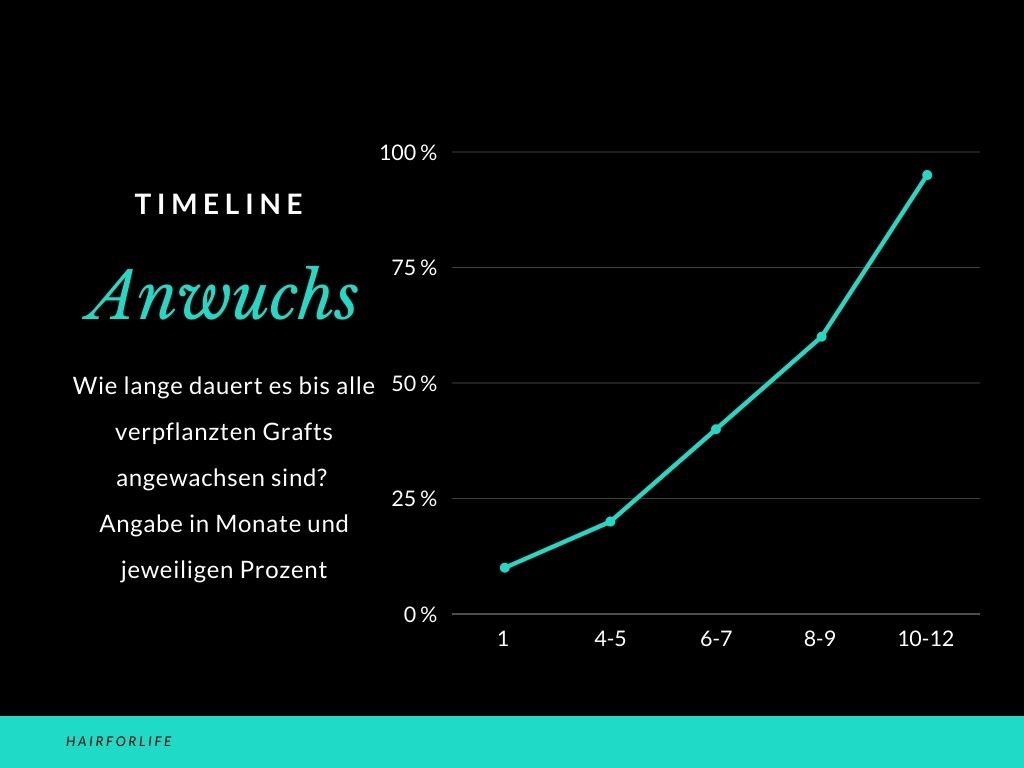
No, but it would be advisable. Although the transplanted hair will not fall out for a lifetime after the hair transplantation, the existing hair can continue to fall out due to hereditary hair loss. Therefore, if the hair loss progresses, in many cases a hair transplant must be performed again. Medications such as finasteride or minoxidil can help to slow down further hair loss as much as possible, or in the best case even stop it. This means that you can enjoy the results for longer.
In principle, no hair transplant is completely without scars! With the u003ca href=u0022https://hairforlife-international.com/en/hair-transplant/fut-strip-hair-transplant/u0022 data-type=u0022pageu0022 data-id=u00222338u0022u003eFUT strip hair transplant techniqueu003c/au003e, a linear scar is created, which, however, can usually be sufficiently concealed by longer hair in the hair crown, and with an u003ca href=u0022https://hairforlife-international.com/en/hair-transplant/fue-hair-transplant/u0022 data-type=u0022pageu0022 data-id=u00222336u0022u003eFUE hair transplantu003c/au003e, small fine round scars are created, which, however, are usually hardly perceived as scars by outsiders, even with short hair.
No. The costs of hair restoration are not usually covered by health insurance.
The importance of follicular units for hairlines
Info on the natural bundling of hair = follicular units and its importance in hair transplantation
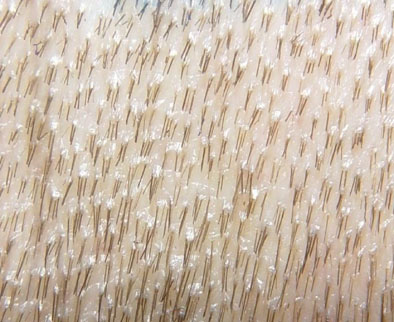
Over the years it has been discovered that hair does not grow individually but in natural bundles, the follicular units (FU’s). These follicular units usually contain between 1 – 4 hair follicles.

If you take a closer look at natural hairlines with a microscope, you will notice that there is a very high proportion of follicular units (FU’s) with 1 hair follicle.
This is one of the reasons why earlier hairlines often looked unnatural after a hair transplant, because, for example, with mini/micro-grafts, sometimes up to 7 hair follicles were transplanted in one graft
In modern hair restoration, however, only follicular units are transplanted, which, as mentioned above, usually contain 1 – 4 hair follicles. In the hairline, 1 follicular unit (follicular unit with 1 hair follicle) is preferred and in areas behind this, 2, 3, and 4 follicular units are also transplanted.
Survey among ISHRS surgeons – Which celebrity/star/actor has the best hair situation: Brad Pitt, Chris Hemsworth, Rai Malek, or Gerhard Butler?

Among ISHRS doctors, 53.9% thought Brad Pitt had the best hair situation, followed by Chris Hemsworth at 30.3%, and trailing behind were Gerard Butler and Rami Malek1
FACTS regarding a hairline as natural as possible through a hair transplant: No multiple follicular units (multis) in the front line
However, since follicular units (FU’s) can also contain multiple hair follicles, care should be taken to avoid inserting units (FU’s) with multiple hair into the hairline, even with a hair transplant using the FUE and FUT methods. In this case, the insertion of follicular units would also lead to unattractive results in a hair transplantation of a hairline.
Likewise, the hair surgeon should pay attention to the correct direction of growth during hair transplant and front grafts should not be placed in “rows and rows” (straight), but in accordance with nature in alternating, irregular densities or arrangements.
Example 1: Conservative approach, low density

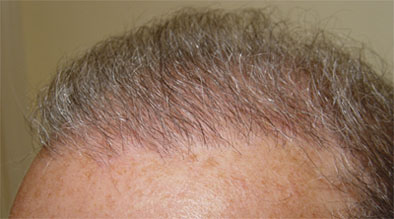

Example 2: Aggressive APPROACH, higher density (Dense Packing)

Facts about “Dense Packing”: If the grafts are transplanted very densely on a square cm area, this is called Dense Packing. Read here more about Dense Packing.
Example 3 of a natural and successful restoration result: Thickening and filling of the receding FRONT
Example 4 of an unnatural RESULT IN THE FRONT with thick multigrafts and wrong growth direction, with subsequent repair/repair
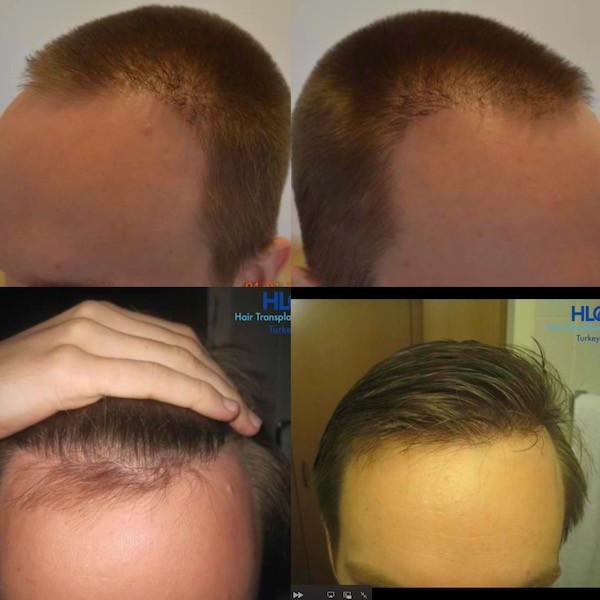
Hair Restoration Surgery and the expectations of the result: Thin and straight hair achieve less visual effect than thick curly hair
In the collaborative article “Hair Restoration Surgery: The State of the Art”7 by Dr. Francisco Jimenez, Dr. John Cole, Dr. Sharon Ann Keene, Dr. James A Harris, Dr. Alfonso Barrera, and Dr. Paul T Rose, it is stated about the expectations of the result that it cannot be stressed enough to the patient that it is the donor’s own characteristics that determine the visual fullness of the result. For example, patients with a thick hair shaft (>80 microns) are better candidates for an autologous hair transplant than those with thin hair (<60 microns). Even when such characteristics have high transplanted densities per sq cm (>40 FU/cm2), individuals with fine, straight hair often have a more “translucent” result compared to those with thick and curly hair which may even have been transplanted at a lower density. In addition, patients with low follicular density (1-2 FU) will have a sparser result with an autologous hair transplant than patients with higher follicular density (3-5 FU).
FOLLICULAR DENSITY HAS AN IMPACT ON THE RESULT THAT IS SIGNIFICANT! THE SAME NUMBER OF GRAFTS DOES NOT CORRESPOND TO THE SAME NUMBER OF TRANSPLANTED HAIR, WITH EXAMPLE
As described above, modern hair transplantation techniques involve the transplantation of so-called follicular units. A follicular unit consists of 1 – 4 hair follicles. In the article “Hair Restoration Surgery: The State of the Art“7 it is described again that the follicular density has a great influence on the result. We would like to illustrate this briefly with an example (the table can be scrolled to the left and right depending on the screen resolution):
| Hair transplant in patient A | Hair transplant in patient B |
|---|---|
| Transplanted number of grafts/FU’s 3500 | Transplanted number of grafts/FU’s 3500 |
| Follicle density per FU = 1.5 hair follicles | Follicle density per FUE = 2.5 hair follicles |
| Total number of follicles transplanted = 5250 | Total number of follicles transplanted = 8750 |
Patient A receives a total of 3500 fewer hair than Patient B, which ultimately affects the visual result of the hair transplant!
Before and after examples
Some more before and after examples of successful hair transplant can be found on our Instagram channel and also on the before and after pictures subpage.
Sources/References/Author
1 ISHRS Practice Census Results Published 2020
2 https://www.ncbi.nlm.nih.gov/pmc/articles/PMC2825128/
3 https://www.haarerkrankungen.de/therapie/alopeciaandrogenetica_w_lichtungsmuster.htm
4 https://www.haarerkrankungen.de/therapie/haartransplantation_indikationen.htm
5 https://www.researchgate.net/publication/303690534_Body_Hair_Transplant_by_Follicular_Unit_Extraction_My_Experience_With_122_Patients
6https://www.researchgate.net/publication/233738772_Hair_Restoration_Surgery_The_State_of_the_Art


